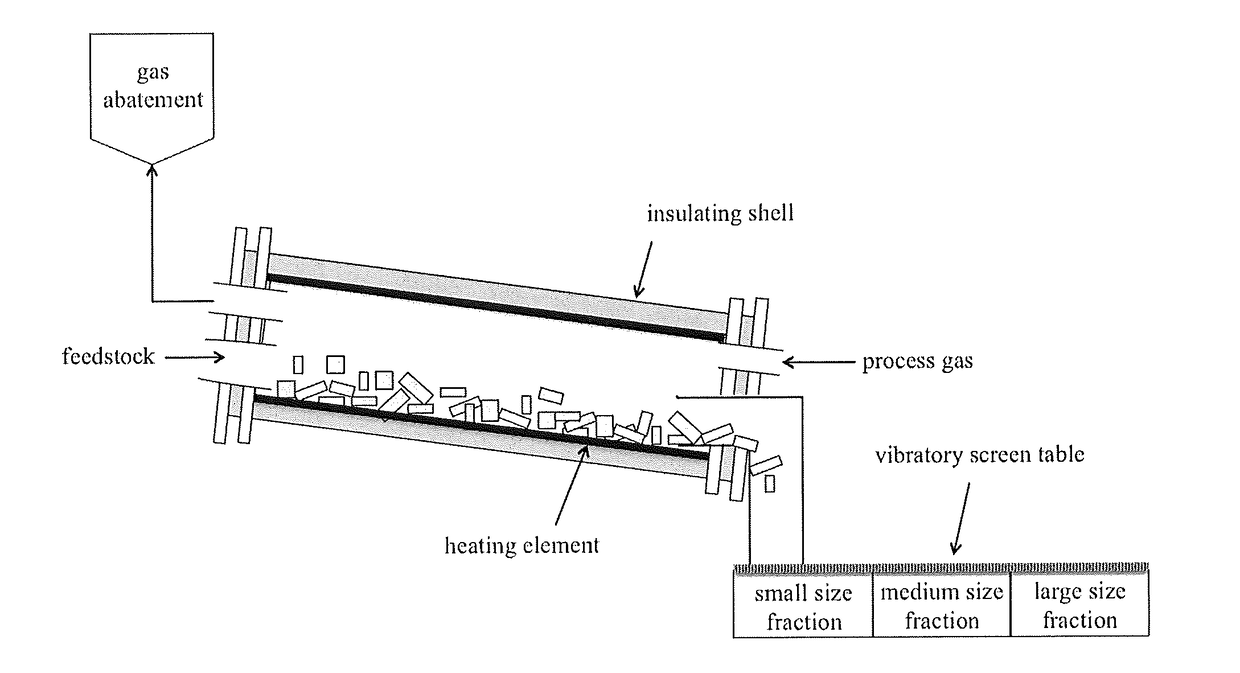Method and apparatus for separation and size reduction of noble metal containing sources
a noble metal and containing material technology, applied in the direction of chemistry apparatus and processes, grain treatment, transportation and packaging, etc., can solve the problems of inability to recover electronic components in such a process, process unsafe, and inability to meet the requirements of environmental protection, so as to facilitate the tumbling of electronic waste materials, enhance the tumbling action of waste materials, and improve the mixing and processing of parts
- Summary
- Abstract
- Description
- Claims
- Application Information
AI Technical Summary
Benefits of technology
Problems solved by technology
Method used
Image
Examples
example 1
[0062]A mixture comprising printed wire boards extracted from various type smartphones, weighing 1340 grams was introduced into a dual zone rotary tube kiln, model GSL-1600X-R60-II, with a 2.4″ O.D. alumina tube fitted with tumbler fins. The kiln was set to a rotational speed of 7 rpm and a temperature of 230° C., that slightly above the softening temperature of the solder and adhesives contained in the smartphone, in an inert atmosphere such as nitrogen, leading to complete separation of the components from the boards while preventing oxidation of the solder metals.
[0063]The resulting separated pieces, specifically 1200 grams of bare boards and a combined 140 grams of metal shields, integrated circuits and other components, exited the rotary kiln and were easily separated according to their size using a vibratory screen, with the bare boards being significantly larger than the ICs and other components. The magnetic pieces contained component mixture was separated from the micro com...
example 2
[0065]A palladium-containing carbon-based catalyst from hydro-processing waste was processed using the present invention. Five kilograms of the catalysts, with metal assay comprising 2010 ppm of palladium with the balance being carbon, was introduced into a rotary kiln and heated to 375° C. in air to convert the carbon to carbon dioxide and water which was subsequently treated in an afterburner located on the exterior of the rotary kiln. The resulting sample weight loss was 99.8%, leaving behind 10.03 grams of palladium in the form of its oxide, for a recovery rate of palladium of 99.8%. The kiln was purged with nitrogen gas to remove any remaining oxygen content and then purged with hydrogen gas at 550° C. to convert the PdOx to 99.9% Pd metal.
[0066]For the foregoing it is seen that advantages of the present invention include: (i) separation and size reduction of non-metal and / or metal-bearing sources in a high throughput low labor manner; (ii) the process avoids the use of toxic a...
PUM
| Property | Measurement | Unit |
|---|---|---|
| temperature | aaaaa | aaaaa |
| auto ignition temperature | aaaaa | aaaaa |
| auto ignition temperature | aaaaa | aaaaa |
Abstract
Description
Claims
Application Information
 Login to View More
Login to View More - R&D
- Intellectual Property
- Life Sciences
- Materials
- Tech Scout
- Unparalleled Data Quality
- Higher Quality Content
- 60% Fewer Hallucinations
Browse by: Latest US Patents, China's latest patents, Technical Efficacy Thesaurus, Application Domain, Technology Topic, Popular Technical Reports.
© 2025 PatSnap. All rights reserved.Legal|Privacy policy|Modern Slavery Act Transparency Statement|Sitemap|About US| Contact US: help@patsnap.com



